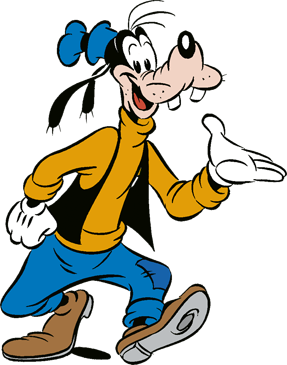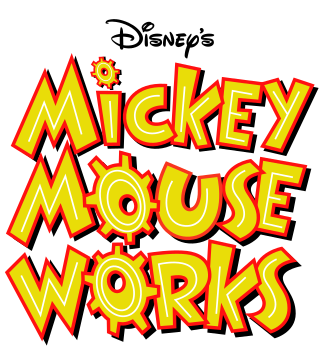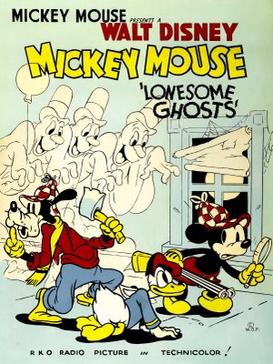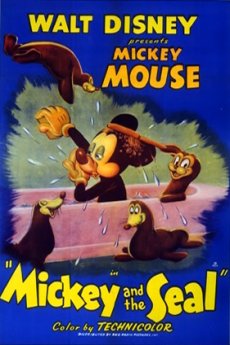
Pluto is an American cartoon character created by the Walt Disney Company. He is a yellow-orange color, medium-sized, short-haired dog with black ears. Unlike most Disney characters, Pluto is not anthropomorphic beyond some characteristics such as facial expression. He is Mickey's pet. Officially a mixed-breed dog, he made his debut as a bloodhound in the Mickey Mouse cartoon The Chain Gang. Together with Mickey Mouse, Minnie Mouse, Donald Duck, Daisy Duck, and Goofy, Pluto is one of the "Sensational Six"—the biggest stars in the Disney universe. Though all six are non-human animals, Pluto alone is not dressed as a human.

Goofy is an American cartoon character created by the Walt Disney Company. He is a tall, anthropomorphic dog who typically wears a turtle neck and vest, with pants, shoes, white gloves, and a tall hat originally designed as a rumpled fedora. Goofy is a close friend of Mickey Mouse and Donald Duck, and is Max Goof's father. He is normally characterized as hopelessly clumsy and dim-witted, yet this interpretation is not always definitive; occasionally, Goofy is shown as intuitive and clever, albeit in his own unique, eccentric way.

Mickey Mouse Works is an American animated television series produced by Walt Disney Television Animation featuring Mickey Mouse and his friends in a series of animated shorts. The first Disney television animated series to be produced in widescreen high definition, it is formatted as a variety show, with skits starring Mickey Mouse, Minnie Mouse, Donald Duck, Daisy Duck, Goofy, Pluto and Ludwig Von Drake while Horace Horsecollar, Clarabelle Cow, Morty and Ferdie Fieldmouse, Huey, Dewey and Louie, Chip 'n' Dale, Scrooge McDuck, Pete, Humphrey the Bear, J. Audubon Woodlore, Dinah the Dachshund, Butch the Bulldog, Mortimer Mouse, José Carioca, and Clara Cluck appear as supporting or minor characters. Musical themes for each character were composed by Stephen James Taylor with a live 12-piece band and extensive use of the fretless guitar to which the music of the series was nominated for an Annie Award in both 1999 and 2001. Most of the shorts from the series were later used in House of Mouse.

Humphrey the Bear is a cartoon character created in 1950 at Walt Disney Animation Studios. He first appeared in the 1950 Goofy cartoon Hold That Pose, in which Goofy tried to take his picture. After that he appeared in four classic Donald Duck cartoons: Rugged Bear (1953), Grin and Bear It (1954), Bearly Asleep (1955), and Beezy Bear (1955).

Tony Anselmo is an American voice actor and animator. He has been the official character voice of Donald Duck since 1985 following the death of the original voice actor, Clarence Nash. He has also provided voices for Donald's triplet nephews, Huey, Dewey, and Louie.
Alfred Julius Eugster was an American animator, writer, and film director. He worked for a number of American animation studios, including Fleischer Studios, the Iwerks Studio, Walt Disney Productions, and Famous Studios.
This is a list of appearances made by Donald Duck in Disney features and cartoons.

Society Dog Show is a Mickey Mouse cartoon short produced by Walt Disney Productions and released by RKO Radio Pictures on February 3, 1939. The animated short was directed by Bill Roberts and animated by Al Eugster, Shamus Culhane, Fred Moore, John Lounsbery, Norm Ferguson, and Leo Salkin. It was the 104th short in the Mickey Mouse film series to be released, and the first for that year.
On Ice is a 1935 theatrical cartoon short in the Mickey Mouse film series, produced by Walt Disney Animation Studios. It was the 79th Mickey Mouse short film to be released, and the eighth of that year.

Lonesome Ghosts is a 1937 Disney animated cartoon, released through RKO Radio Pictures on Christmas Eve, three days after Snow White and the Seven Dwarfs (1937). It was directed by Burt Gillett and animated by Izzy (Isadore) Klein, Ed Love, Milt Kahl, Marvin Woodward, Bob Wickersham, Clyde Geronimi, Dick Huemer, Dick Williams, Art Babbitt, and Rex Cox. The short features Mickey Mouse, Donald Duck & Goofy as members of The Ajax Ghost Exterminators. It was the 98th short in the Mickey Mouse film series to be released, and the ninth for that year.

Mickey and the Seal is a cartoon short created by Walt Disney in 1948. It was nominated for Academy Award for Best Animated Short Film, but lost to MGM's Tom and Jerry cartoon The Little Orphan, which shared one of seven Oscars for the Tom and Jerry series. It was the 122nd short in the Mickey Mouse film series to be released, and the second produced that year.

Oliver George Wallace was an English composer and conductor. He was especially known for his film music compositions, which were written for many animation, documentary, and feature films from Walt Disney Studios.
Walt Disney's Funny Factory is a series of DVDs by Walt Disney Home Entertainment. Very similar to the Walt Disney's Classic Cartoon Favorites line, each release would feature around one-hour of Disney animated short films, grouped by a starring character, or set of characters. As opposed to the chronological nature of the Walt Disney Treasures line, each release would feature various cartoons in no particular order. The series featured two waves of releases, on January 17, 2006, and November 21, 2006.

Moving Day is a 1936 American animated short film produced by Walt Disney Productions and released by United Artists. The cartoon, set during the contemporary Great Depression, follows the antics of Mickey Mouse, Donald Duck, and Goofy as they frantically pack their belongings after being dispossessed from their home. The film was directed by Ben Sharpsteen and includes the voices of Walt Disney as Mickey, Clarence Nash as Donald, Pinto Colvig as Goofy, and Billy Bletcher as Sheriff Pete. It was the 85th Mickey Mouse short to be released, and the eighth of that year.

Ferdinand the Bull is a 1938 American stand-alone animated short produced by Walt Disney Productions and released on November 25, 1938, by RKO Radio Pictures. It was directed by Dick Rickard and based on the 1936 book The Story of Ferdinand by Munro Leaf. The music was by Albert Hay Malotte, most known for his setting of The Lord's Prayer, commonly sung at weddings.

Tea for Two Hundred is an American animated short film directed by Jack Hannah. Part of the Donald Duck film series, the film was produced in Technicolor by Walt Disney Productions and released to theaters by RKO Radio Pictures on December 24, 1948. The cartoon stars a picnicking Donald Duck who faces an army of African ants trying to steal his food. Clarence Nash stars as Donald while the ants were voiced by Pinto Colvig. The film includes original music by Oliver Wallace.

The Whalers is a cartoon produced by Walt Disney Productions, released by RKO Radio Pictures on August 19, 1938, and featuring Mickey Mouse, Donald Duck and Goofy.

Pluto's Christmas Tree is a 1952 Mickey Mouse cartoon in which Pluto and Mickey cut down a Christmas tree that Chip n' Dale live in. It was the 125th short in the Mickey Mouse film series to be released, and the second for that year. While the chipmunks are usually antagonists of Donald Duck, they have pestered Pluto before, in Private Pluto (1943), Squatter's Rights (1946) and Food for Feudin' (1950).
The Gorilla Mystery is a 1930 Mickey Mouse animated film produced by Walt Disney for Columbia Pictures, as part of the Mickey Mouse film series. It was the twenty-second Mickey Mouse short to be produced, the seventh of that year.














